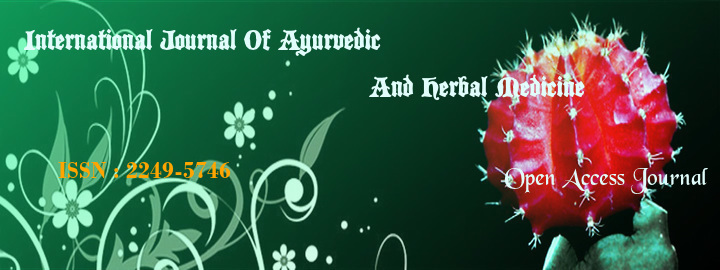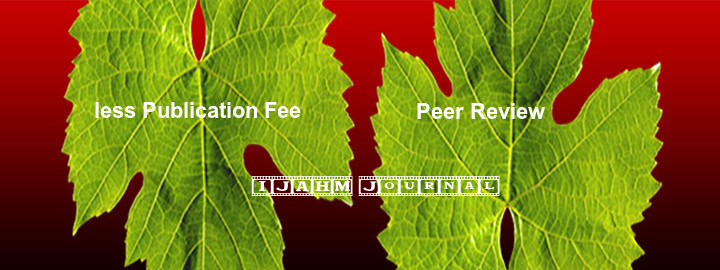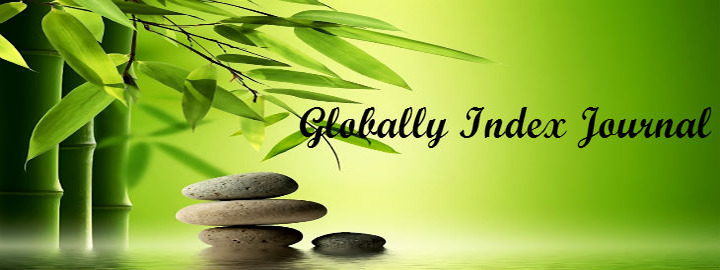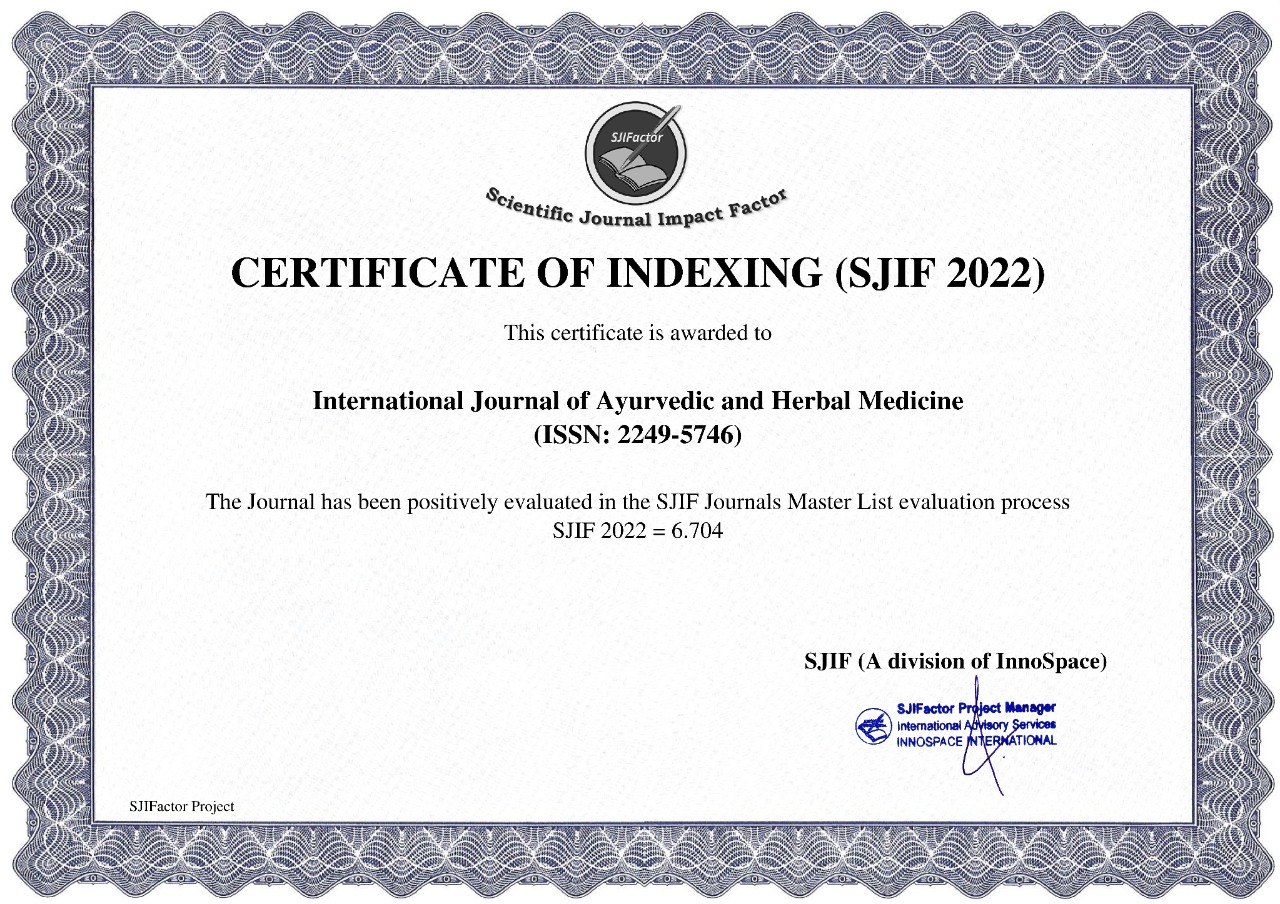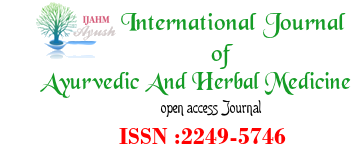


1Pansare T.A. , 2Khandekar S.B. , 3Satpudke S.S.
1Associate professor of Dravyaguna Department, Government Ayurvedic College, Osmanabad, Maharashtra.
2PG Scholar (Dravyaguna),Government Ayurvedic College, Osmanabad, Maharashtra
ABSTRACT:
Medicinal plants are being used widely, either as single drug or in combination in health care delivery system Hemidesmus indicus R.Br, also popularly known as ‘Anantmul’in Marathi ‘Sariva’ in Sanskrit and ‘Indian sarsaparilla’ in english is a semi erect shrub belonging to family Asclepiadaceae. It is widely distributed throughout India.It contains various phytoconstituents belonging to the category glycosides, flavonoids, tannins, sterols and volatile oils. It is traditionally used in skin disorders, dysentery, diarhhoea, syphilis, dyspepsia, leucoderma burning sensation, chronic fever and asthma,leprosy, loss of appetite, eye diseases, epileptic disorder, dyspepsia, nutritional disorder,leucoderma ,ulcer and rheumatism and used for diuretic and blood purifier purpose. Pharmacological studies carried out with its extract and purified compounds indicate that this plant possess antioxidant, hepatoprotective, anti-ulcer, antimicrobial, anticancer, hypoglycemic, antithrombotic, antihyperlipidemic, otoprotective, analgesic, anti-inflammatory and immunomodulatory activities. It also protects radiation-induced DNA damage. This review provides comprehensive and unique information regarding ayurvedic and modern aspect of sariva under one umbrella which will be helpful to researchers and pharmaceutical industries to expand the pharma worth of this wonder drug.
Key words- Sariva, Hemidesmus indicus, Asclepiadaceae, Anantmul
REFERENCES
1. Anonymous. The Ayurvedic Pharmacopoeia of India, , Government of India, Ministry of Health and Family Welfare, Dept. of ISM and Homoeopathy, New Delhi; 2001:Vol.I: pg.107-108.
2. Gogte VM. Ayurvedic Pharmacology and Therapeutic uses of Medicinal Plants, Bhartiya Vidhya Bhavan, Mumbai 2000; 1st Edn: pg.512-513.
3. Gupta NS. The Ayurvedic System of Indian Medicine, Bharatiya Kala Prakashan, New Delhi; 2006: Vol. I: pg.96-97.
4. Khare CP. Encyclopedia of Indian Medicinal Plants, New York;2004: 245247.
5. Sharma PC, Yelne MB, Dennis TJ. Database on medicinal plants used in Ayurveda, Central Council for Research in Ayurveda & Siddha, New Delhi; 2000: Vol. I: 394403
6. Charak Samhita, Kashinath Sastri,Chaukhambha Bharti Academy, Varansi, Reprint 2013 pg.79, 80, 84, 92, 93
7. Bhavprakash nighantu, Dr.G.S Pandy, Chaukhamba bharti academy, Varanasi. 2013: pg. 411,412,413
8. Nadkarni, A.K Indian materia medica, popular Prakashan, pvt limited; vol-2: pg.619-622
9. Dravyaguna-vijnana, P.V. Sharma, Chaukhabha Bharti Academy, Varanasi Reprint 2015; vol 2:pg.798
10. Pr of Psriyavat Sharma and Guruprasad Sharma, Dhanvantari Nighantu (Hindi translation). Varanasi; Chaukhamba oriental; (1998); 2nd edition: Pg.45-46
11. Prof Priyavat Sharma & Guru Prasad Sharma, Kaiyyadev Nighantu (Hindi translation); Chaukhamba oriental; (1979); 1 st edition Delhi: pg.183-184
12. Dr. Indradeo Tripathi Raj Nighantu (Hindi translation). Bharati Acadamy Varanasi, 2003; 3rd edition: pg.419-420
13. Pandit.Hariprasad Tripathi, Madanpal Nighantu (Hindi translation) Varanasi; Chaukhamba Krishnadas academy; (2009); 1st edition : p-17-18
14. Gupta NS. The Ayurvedic System of Indian Medicine, New Delhi, Bharatiya Kala Prakashan, 2006: pg.309.
15. www.disabled-world.com, accessed on 12th August, 2008.
16. Anonymous, The Wealth of India: A Dictionary of Indian Raw Materials and Industrial Products, National Institute of Science Communication, New Delhi, ISBN: 2001; Vol.2 81:7236-2137.
17. Anonymous; The Ayurvedic Pharmacopoeia of India, Ministry of Health and Family Welfare, Department of Health, Govt. of India, New Delhi, 1989: 1st Edn: pg.107-108
18. https:// en.m.Wikipedia.org
19. Aiyer K.N. Pharmacognosy of Ayurvedic Drugs of Travancore, Cochin. Central Research Institute, Trivandrum ;1951.
20. Warrier P.K., Nambiar V.P.K. and Ganapathy P.M. Some important medicinal plants of the Western Ghats, India-A profile. Int. Develop. Res. Centre; 2000: pg 159-174.
21. Sethi A, Srivastav SS, Srivastav S. Pregnane glycoside from Hemidesmus indicus. Indian J Heterocycl Chem 2006; 16:191-192.
22. Austin A. A review on Indian Sarsaparilla, Hemidesmus indicus (L.) R. Br. J Biol Sci 2008; 8(1):1-12.
23. Ravishankara MN, Shrivastava N, Padh H, Rajani M. Evaluation of antioxidant properties of root bark of Hemidesmus indicus R. Br. (Anantmul). Phytomedicine 2002; 9:153–160.
24.Mohana Rao GM, Venkateswararao Ch, Rawat AKS, Pushpangadan P, Shirwaikar A. Antioxidant and Antihepatotoxic activities of Hemidesmus indicus R. Br. Acta Pharmaceutica Turcica 2005; 47:107–113.
25. Sultana S, Khan N, Sharma S, Alam A. Modulation of biochemical parameters by Hemidesmus indicus in cumene hydroperoxide-induced murine skin: possible role in protection against free radicals-induced cutaneous oxidatve stress and tumor promotion. J Ethnopharmacol 2003; 85:33–41.
26. Nadana S, Namasivayam N. Impact of Hemidesmus indicus R.Br. extract on ethanol-mediated oxidative damage in rat kidney. Redox Report 2007; 12(5):229-235.
27. Kumar GS, Jayaveera KN, Kumar Ashok CK, et al. Evaluation of antioxidant and antiacne properties of terpenoidal fraction of Hemidesmus indicus (Indian sarsaparilla). The Internet Journal of Aesthetic and Antiaging Medicine 2008; 1 (1).
28. Mahalingam G, Krishnan K. Hypoglycemic activity of Hemidesmus indicus on streptozotocin induced diabetic rats. Int J Diab Dev Ctries 2008; 28(1):6-10.
29. Mookan P, Rangasamy A, Thiruvengadam D. Protective effect of Hemidesmus indicus against rifampicin and isoniazid-induced hepatotoxicity in rats. Fitoterapia 2000; 71:55-59.
30. Baheti JR, Goyal RK, Shah GB. Hepatoprotective activity of Hemidesmus indicus R. br. in rats. Indian J. Exp. Biol. 2006; 44(5):399-402.
31. Nadana S, Namasivayam N. Inhibitory effect of Hemidesmus indicus and its active principle 2-hydroxy 4-methoxy benzoic acid on ethanol-induced liver injury. Fundam Clin Pharmacol 2007; 21(5):507-514. 22
32. Hiremath SP, Rudresh K, Badami S. Antimicrobial activity of various extracts of Striga sulphurea and Hemidesmus indicus. Indian J. Pharm. Sci. 1997; 59(3):145-147.
33. Das S, Devaraj SN. Antidiarrhoeal effect of methanolic extract of Hemidesmus indicus an invitro and invivo study. Indian J Exp Biol 2003; 41(4):363-366.
34. Das S, Devaraj SN. Antienterobacterial activity of Hemidesmus indicus R. Br.root extract. Phytother Res 2006; 20(5):416-421.
35. Das S, Devaraj SN. Glycosides Derived from Hemidesmus indicus R. Br.root inhibit adherence of Salmonella typhimurium to Host Cells: Receptor Mimicry. Phytother Res 2006; 20:784–793.
36. Gopiesh Khanna V, Kannabiran K. Larvicidal effect of Hemidesmus indicus, Gymnema sylvestre and Eclipta prostrata against Culex qinquifaciatus mosquito larvae. Afr J Biotechnol 2007; 6(3):307-311.
37. Kumar GS, Jayaveera KN, Ashok Kumar CK, et al. Antimicrobial effects of Indian medicinal plants against acne-inducing bacteria. Trop J Pharm Res 2007; 6(2):717723.
38.Iddamaldeniya SS, Thabrew MI, Wickramasinghe SMDN, Ratnatunge N, Thammitiyagodage MG. Protection against diethylnitrosamine-induced hepatocarcinogenesis by an indigenous medicine comprised of +igella sativa, Hemidesmus indicus and Smilax glabra-a preliminary study. J Carcinogenesis 2003; 2:1-6.
39. Iddamaldeniya SS, Thabrew MI, Wickramasinghe SMDN, Ratnatunge N and Thammitiyagodage MG. A long term investigation of antihepatocarcinogenesi potential of an indigenous medicine comprised of +igella sativa, Hemidesmus indicus and Smilax glabra. J Carcinogenesis 2006; 5:11.
40. Das S, Devaraj SN. Protective Role of Hemidesmus indicus R. Br. Root Extract against Salmonella typhimurium induced Cytotoxicity in Int 407 Cell Line. Phytother Res 2007; 21:1209–1216.
41. Shetty TK, Satav JG, Nair CK. Radiation protection of DNA and membrane in vitro by extract of Hemidesmus indicus. Phytother Res 2005; 19(5):387-90
42. Mary NK, Achuthan CR, Babu BH, Padikkala J. In vitro antioxidant and antithrombotic activity of Hemidesmus indicus (L) R.Br. J Ethnopharmacol 2003; 87:187–191.
43. Mary NK, Achuthan CR, Babu BH, Padikkala J. Antiatherogenic effect of Caps HT2, a herbal Ayurvedic medicine formulation. Phytomedicine 2003; 10:474–482.
44. Bopanna KN, Bhagyalakshmi N, Rathod SP, Balaraman R, Kannan J. Cell culture derived Hemidesmus indicus in the prevention of Hypercholesterolemia in normal and hyperlipidemic rats. Indian J Pharmacol 1997; 29:105-109.
45. Anoop A, Jegadeesan M. Biochemical studies on the anti-ulcerogenic potential of Hemidesmus indicus R.Br. var. indicus. J Ethnopharmacol 2003; 84:149-156.
46. Das Sarita and Niranjali Devaraj S. Antienterobacterial activity of Hemidesmus indicus R. Br. root extracts. Phytotherapy Research, 2006; 20(5): 416-421.
47. Navneet B, Gadge and Sunil S. Jalalpure Natriuretic and saluretic effects of Hemidesmus indicus R. Br. Root extracts in rats. Indian Journal of Pharmacology, 2011; 43(6): 714– 717.
48. Verma P.R, Joharapurka R.A.A, Chatpalliwar V.A and Asnani A.J. Antinociceptive activity of alcoholic extract of Hemidesmus indicus R. Br. in mice. Journal of Ethno Pharmacology, 2005; 102: 298–301.
49. Ratha M, Subha K, Senthil kumar G and Panneer selvam A. Screening of phytochemical and antibacterial activity of Hemidesmus indicus (L.) and Vetiveria zizanoides (L.), Journal of Experimental Biology. 2012; 2 (2): 363-368.
50. Prabakan M, Anandan R and Devaki T. Protective effect of Hemidesmus indicus against rifampicin and isoniazide induced hepatotoxicity in rats. Fitoterapia. 2000; 71: 55–90
51. Sariba. Hemidismus indicus on wound healing. International Rresearch Journal of pharmacy. 2012; 3(3): 277-281.
52. Bahati J.R, Goyal R.K and Shah G.B. Hepatoprotective activity of Hemidismus indicus R.Br. in rats. Indian Journal of Experimental Biology. 2006; 44: 399-402.
53. Alam M.I, Auddy B and Gomes A. Viper Venom neutralization by Indian medicinal plant Hemidesmus indicus and Pluchea indica root extract. Phytotherapy Research. 1996; 10(1): 58-61. Anoop
54. Verma PR, Joharapurkar AA, Chatpalliwar VA, Asnani AJ. Antinociceptive activity of alcoholic extract of Hemidesmusindicus R.Br. in mice. J Ethnopharmacol 2005;102:298–301.
55 Anoop Austin and Jegadeesan, M., Anti-ulcer potential of Hemidesmus indicus var pubescens R.Br., Hamdard Medicus, 46,3, (2003).(Accepted)
index







